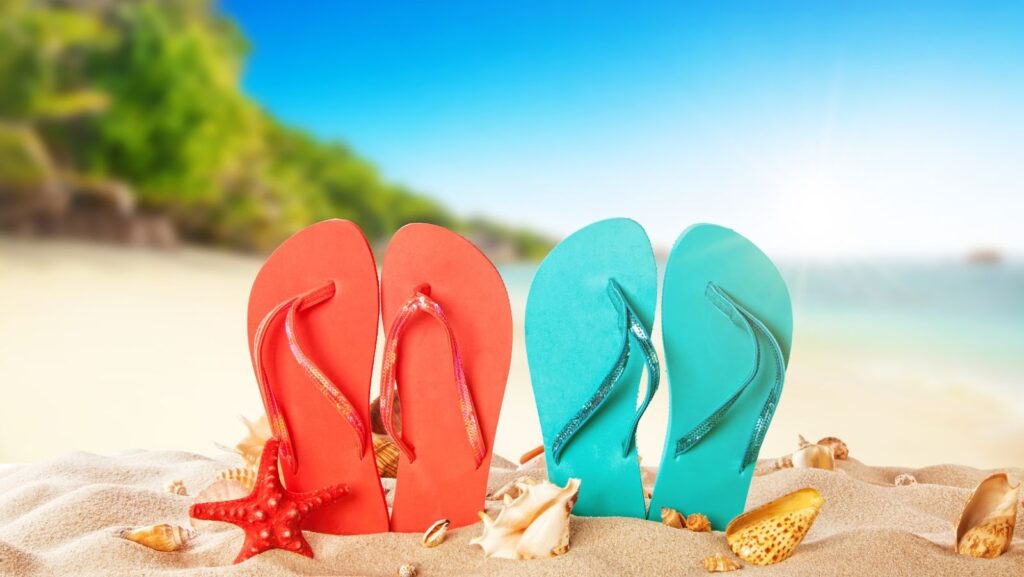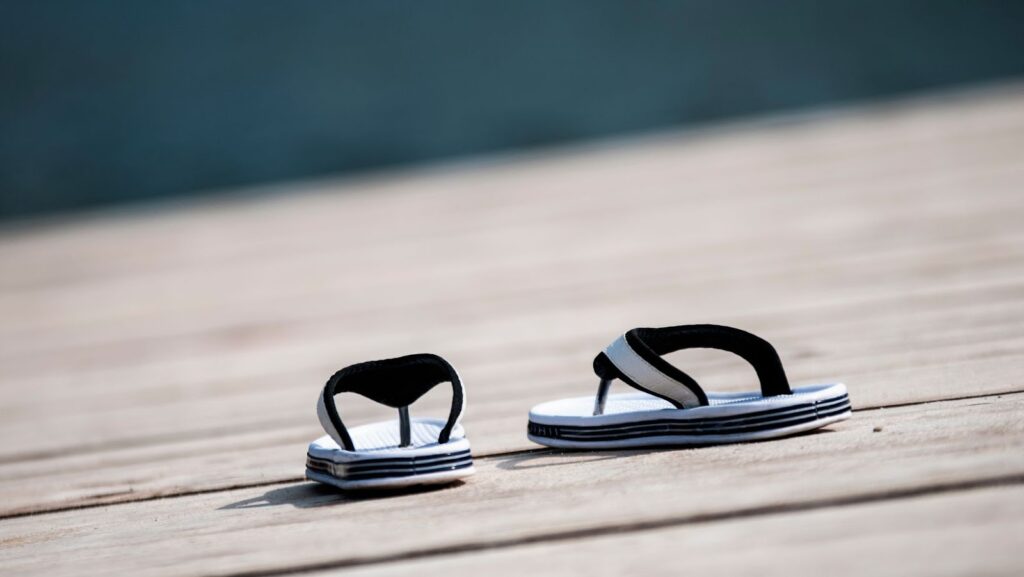Cleaning your Reef Flip Flops is crucial to maintaining their longevity and preventing any damage to them. Regular cleaning not only improves their appearance, but it also removes any dirt or debris that can cause harm. Neglecting this simple task can quickly lead to wear and tear or even changes in the shape of the soles.
Moreover, proper cleaning helps prevent odors from developing and spreading bacteria or fungi. It is recommended to clean your sandals every few weeks with a mild soap and a soft-bristle brush. Make sure to rinse thoroughly and leave them out to air dry.
In addition, it is essential to store your Reef Flip Flops in a cool and dry place after each use. Keeping them away from direct sunlight or moisture will extend their lifespan.
“I remember my last summer vacation when I donned my favorite pair of Reef Flip Flops for a day at the beach without cleaning them. To my dismay, sand and sea salt had accumulated on the sole, causing discomfort while walking around the beachfront shops. Lesson learned – always clean your flip flops after each use to maximize comfort and increase their durability.”
Grab your rubber gloves and your sense of adventure, because we’re about to get down and dirty with the materials needed to clean your reef flip flops.
How to Clean Reef Flip Flops
To effectively clean your Reef Flip Flops and reap their benefits, you must prepare your materials beforehand. Here are the essential items to do so:
- A basin filled with warm water
- Dish soap or specialized cleaner for footwear
- A soft-bristled brush or toothbrush
- A dry towel for drying the footwear after cleaning
It is important to note that using harsh chemicals and bleach can damage your flip flops’ material, so it is best to stick with mild soap solutions when cleaning.
In addition, take care of any stubborn stains by spot cleaning them before immersing in water. Additionally, ensure that you air-dry your flip flops away from direct sunlight and extreme heat to prevent warping or shrinkage.
Pro tip: To keep your Reef Flip Flops in excellent condition, make a habit of regularly cleaning them after outdoor use, even if they don’t appear dirty.
Get your gloves and goggles ready, because we’re about to dive into the dirty world of reef flip flop cleaning.
Pre-Cleaning Preparation
For a successful reef flip flops cleaning routine, beginning with appropriate Pre-Cleaning Preparation is crucial. This step involves adequate preparation to ensure that the cleaning process runs smoothly and yields satisfactory results.
Here is a three-step guide to effective Pre-Cleaning Preparation:
- First, you want to gather all the necessary materials such as soap or detergent, sponge, water source, and if applicable-Specific instructions from the manufacturer.
- Next, you should create an adequate working space for yourself by laying down a tarp or old cloth to catch debris that will come off of the flip flops during cleaning.
- Finally, it’s advisable to time your cleaning session when you have plenty of uninterrupted time so that your attention isn’t divided.
It’s important to note that in addition to protecting your work area and gathering supplies before you start cleaning your flip flops, consider wearing gloves for additional protection against harsh cleaning chemicals.
For a more effective Pre-Cleaning Preparation process, check if the flip flops material requires specialized care before undergoing any cleaning process.
Before washing a pair of delicate brown reef flip flops in 2002 caused damage due to improper washing methods; therefore manufacturers now provide specific washing instructions even on the label tags attached to them for customers’ ease and satisfaction.
Cleaning reef flip flops is like scrubbing a tiny aquarium, but with the added bonus of not having to feed the fish.
Cleaning Technique
For optimal performance and longevity, maintaining the cleanliness of your Reef flip flops is crucial. The proper cleaning technique involves removing excess dirt with a soft-bristle brush and applying a gentle cleaner solution. Rinse off the foam and let it air dry in a shaded area, avoiding direct sunlight.
It’s essential to avoid using harsh chemicals or hot water, as they can damage the material of the flip flops and weaken their overall structure. Additionally, it’s recommended to store them in a dry location to prevent mold or mildew growth.
By frequently cleaning your Reef flip flops, you can extend their lifespan and ensure they maintain their comfort and support level. Neglecting this essential step can cause an accumulation of dirt and grime that may result in discoloration, odor buildup, and even foot infections.
To keep your flip flops fresh and clean, consider investing in a protective spray that repels moisture and stains; this will help reduce the amount of dirt that accumulates on the surface.
In summary, properly caring for your Reef flip flops involves regular cleaning with a gentle solution and storage in a dry location. These simple steps guarantee longevity while ensuring hygiene standards are met, so you can continue enjoying your comfortable footwear during any outdoor activity.
Need an alternative to scrubbing your reef flip flops by hand? Just throw them in with your laundry and give your socks a taste of the ocean.
Alternative Cleaning Methods
To diversify Cleaning Methods beyond the norm, there are a few other ways to keep your Reef Flip Flops squeaky clean. Here are some tips:
- Use a soft bristle brush and mild detergent for optimal results.
- Try using baking soda mixed with water for stubborn stains.
- Consider using white vinegar diluted with water to kill bacteria while refreshing the sandals.
- Lastly, air-drying your flip flops after a wash will prevent any mold growth.
An additional method that hasn’t been mentioned before is to dampen a microfiber cloth with rubbing alcohol and gently rub it on the footbed of your Reef Flip Flops. This will quickly remove any dirt or sweat that may have accumulated on them.
Pro Tip: Avoid cleaning Reef Flip Flops in hot water or putting them in the dryer as this can cause damage to the material and reduce their lifespan.
Don’t let your reef flip flops get soggy – master the art of drying and avoid being caught with damp toes.
Drying Techniques
Drying Methods for Reef Flip Flops
To ensure the longevity and effectiveness of your reef flip flops, it is important to take proper care by drying them. Here are some efficient methods:
- Air Dry: After washing, stuff your flip flops with balled-up paper towels or cloth to absorb excess water. Place them in a dry spot away from direct sunlight and allow them to air dry.
- Towel Dry: Wipe any moisture off the flip flops with a soft towel after washing, and hang them over a clothesline or rack to air dry.
- Hairdryer Method: Use a low heat setting on your hair dryer to remove any moisture from the surface of the flip flops evenly.
- Fan Method: Place your flip flops in front of an oscillating fan to speed up the drying process.
- Dehumidifier Method: Put your flip flops in a room with a dehumidifier to extract moisture out of the air around them.
- Rust Prevention: Don’t forget to remove all metallic objects like pins before drying, else they might cause rusting.
Since constant exposure can lead to wear and tear, alternating between these methods is advised.
Another crucial tip is about keeping the straps loose during cleaning and drying since tightening while wet leads to contraction, making them uncomfortable afterward.
Research conducted by ‘The Foot Collective’ states that damp shoes are breeding grounds for bacteria that cause foot infections. Keeping your reef flip flops clean is easy, just like staying single after a messy breakup – it’s all in the aftercare.
After-Cleaning Maintenance
Regular maintenance of your clean reef flip flops is crucial to ensure their longevity. Here is a step-by-step guide on how to perform after-cleaning maintenance for your beloved footwear.
- Dry Them Completely – After cleaning, make sure the flip flops are completely dry before storing them away.
- Apply Conditioner – Use a conditioner specifically designed for leather or synthetic material to maintain the quality and durability of your flip flops.
- Store in a Cool, Dry Place – Keep your flip flops away from direct sunlight and humidity to prevent any further damage.
- Check For Any Visible Wear And Tear – Inspect your flip flops after each use for any visible wear and tear, as early detection can prevent further harm.
In addition, never store wet shoes as it can cause damage to the material, leading to an unpleasant odor and even mold growth.
Ensure the longevity of your reef flip flops by taking proper care of them with these simple after-cleaning maintenance steps. Don’t miss out on enjoying comfortable and fashionable footwear by neglecting their upkeep.
Clean reef flip flops, happy feet, and a guilt-free conscience – what’s not to love?
Conclusion
Regular cleaning of your Reef flip flops is vital for preserving the footwear’s quality and prolonging its lifespan. Not only will this keep your flip flops looking brand new, but it also minimizes the risk of bacterial infections caused by fungi and other microorganisms that thrive in unclean environments.
When cleaning your Reef flip flops, the first step is to remove any visible dirt using a damp cloth or sponge. Next, use a mild detergent to scrub away stubborn stains gently. Rinse the flip flops thoroughly with clean water before drying them naturally or using a towel.
In addition to maintaining hygiene, cleaning your Reef Flip Flops has additional benefits like reducing foot odor and minimizing the risks of contamination and infections that could affect skin health. Doing so ensures that you always have maximum comfort level while wearing Reef flip flops throughout the summer season.
Don’t miss out on maximizing the life span of your favorite Reef Flip Flops by not taking care of them. Take stringent measures to ensure their cleanliness regularly to avoid bacterial infections, bad odor, and random damages caused by dust accumulation on them. Your feet will thank you!

